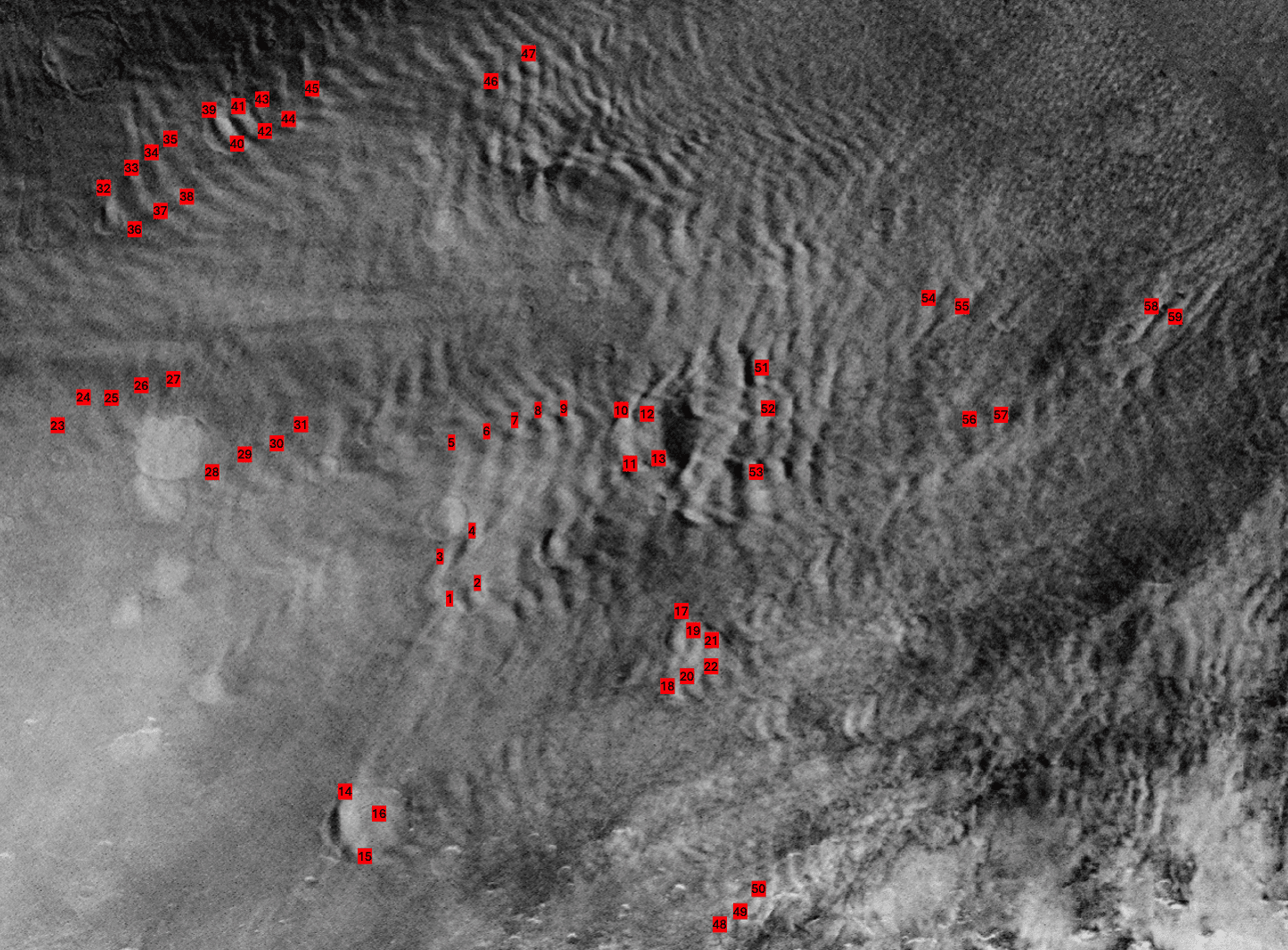Morphological and dynamical characterisation of Gravity Waves on Mars atmosphere using the High-Resolution Stereo Camera on Mars Express
- 1Instituto de Astrofísica e Ciências do Espaço, Lisbon, Portugal (fmbrasil@ciencias.ulisboa.pt)
- 2Faculdade de Ciências da Universidade de Lisboa, Portugal
- 3Instituto de Astrofísica de Andalucía, Granada, Spain
- 4European Space Agency, European Space Astronomy Center, Madrid, Spain
- 5Planetary Atmospheres Group, Institute for Basic Science, Daejeon, South Korea
- 6German Aerospace Center, Institute of Planetary Research, Berlin, Germany
- 7Institut Astrophysique Spatiale, CNRS, Paris-Saclay University, France
- 8Aix Marseille Univ, CNRS, CNES, LAM, Marseille, France
- 9European Space Agency, ESTEC, Noordwijk, Netherlands
Atmospheric gravity waves (GWs) are mesoscale atmospheric oscillations that propagate vertically in stable, stratified planetary atmospheres [1], significantly shaping weather and climate by influencing temperature, wind patterns, and cloud formations. In this study, we present preliminary results of GWs in the Martian atmosphere using the High-Resolution Stereo Camera (HRSC) [2] onboard the European Mars Express (MEx) spacecraft [3]. By taking advantage of high-altitude observations (200-800 m/px) with a field of view from limb to limb, we can investigate the morphological and dynamical properties of GWs. Previous studies using the OMEGA instrument [4] were limited by a narrow field of view, preventing them from capturing the full extent of wave packets.
We have morphologically characterised the wave packets in the high-altitude observations, considering the number of crests, horizontal wavelength, packet width and length, and orientation. Additionally, we retrieved cloud heights using a new method adapted from [5] that utilises the RGB channels of HRSC to measure the altitudes of waves present in the images. In addition to pairs of high-altitude observations taken 30 minutes apart, we estimated wind speeds by tracking the displacement of features between the two images.
Our findings indicate a varied range of altitudes for different cloud types, including water ice clouds ranging from 15-45 km (±5 km error), CO₂ ice clouds from 60-85 km (±5 km error), and dust clouds from 5-10 km (±3 km error). Wind speeds of 5-15 m/s (±10% error) were estimated, and we created regional wind maps across cloud-rich regions (Figure 1). These wind maps reveal the dynamics of mesoscale cloud structures, illustrating how GWs influence wind patterns across the Martian atmosphere. Future research will incorporate OMEGA's spectral data to classify cloud types accurately.

Figure 1 - Gravity waves detected in high-altitude HRSC observations of the region at 40°S, 70°W during Mars Year 36. Red markers pinpoint specific features in wave packets (50 tracers), measured in paired images taken 34 minutes apart. These coordinates are used to calculate wind speeds, aiding in the creation of wind maps with velocities ranging from 5 to 15 m/s, with an error margin of 10%.
Acknowledgements: This work was supported by the Portuguese Fundação Para a Ciência e a Tecnologia of reference PTDC/FIS-AST/29942/2017, through national funds and by FEDER through COMPETE 2020 of reference POCI-01-0145-FEDER-007672, and through a grant of reference 2021.05455.BD. GG acknowledges financial support from Junta de Andalucia through the program EMERGIA 2021 (EMC21_00249) and from the Severo Ochoa grant CEX2021-001131-S funded by MCIN/AEI/ 10.13039/501100011033. IAA is also supported by grant ID2022-137579NB-I00 funded byMCIN/AEI/10.13039/501100011033 and by “ERDF A way of making Europe”. Funded by the ESA Faculty Research Contract and Science Exchange Programme, which is in the frame of the MWWM - Mars Wind and Wave Mapping project of reference ESA RFP/3-17570/22/ES/CM. We thank the Mars Express Team for their support and encouragement in starting this work.
References:
[1] Fritts, D. C., & Alexander, M. J. (2003). Gravity wave dynamics and effects in the middle atmosphere. Reviews of geophysics, 41(1).
[2] Jaumann, R., et al., 2007. The high-resolution stereo camera (HRSC) experiment on Mars Express: Instrument aspects and experiment conduct from interplanetary cruise through the nominal mission. Planetary and Space Science 55, 928-952.
[3] Cardesin-Moinelo, A., et al., 2024. Mars Express: 20 Years of Mission, Science Operations and Data Archiving. Space Science Reviews, 220(2), 25.
[4] Brasil, F., et al., 2024. Atmospheric Gravity Waves in Mars’s Lower Atmosphere: Nadir Observations from OMEGA/Mars Express data. Astronomy and Astrophysics (under revision).
[5] Scholten, F., et al., 2010. Concatenation of HRSC colour and OMEGA data for the determination and 3D-parameterization of high-altitude CO2 clouds in the Martian atmosphere. Planetary and Space Science, 58(10), 1207-1214.
How to cite: Brasil, F., Machado, P., Gilli, G., Cardesin-Moinelo, A., Silva, J. E., Espadinha, D., Tirsch, D., Matz, K.-D., Roatsch, T., Riu, L., Carter, J., and Wilson, C.: Morphological and dynamical characterisation of Gravity Waves on Mars atmosphere using the High-Resolution Stereo Camera on Mars Express, Europlanet Science Congress 2024, Berlin, Germany, 8–13 Sep 2024, EPSC2024-656, https://doi.org/10.5194/epsc2024-656, 2024.